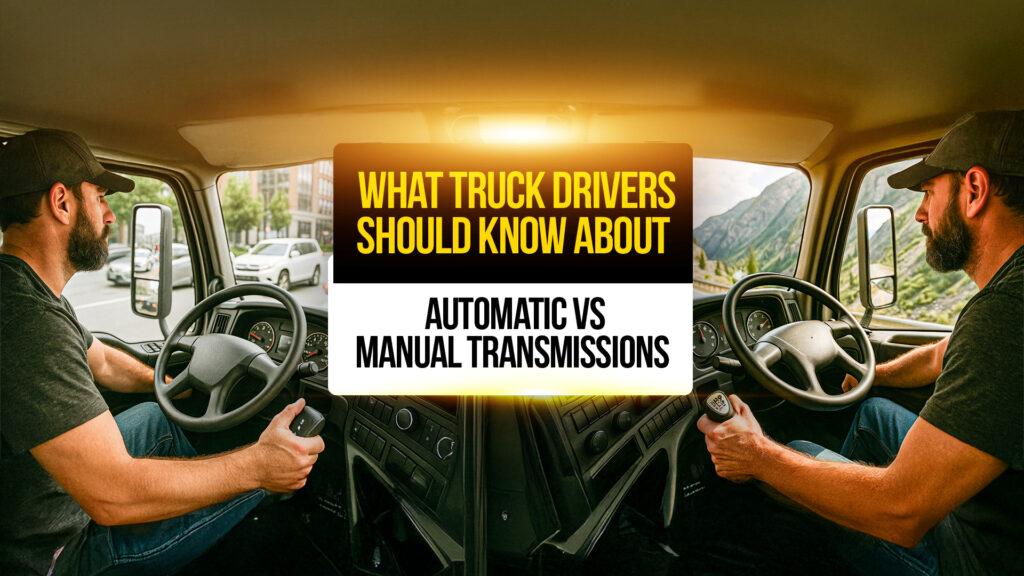
Introduction
The debate between automatic and manual transmissions isn’t new, but in 2025, it’s more relevant than ever. With more fleets switching to automatics and veteran drivers swearing by the control of a manual, it’s worth understanding what’s really changing, and how it affects your pay, comfort, and daily driving.
Whether you’re a new CDL driver or a seasoned hand behind the wheel, this guide breaks down what you need to know before your next job or truck choice.
What’s Really Going On with Truck Transmissions
Over the last decade, automatic and automated manual transmissions (AMTs) have taken over much of the trucking industry. According to the Bureau of Labor Statistics (BLS) and major fleet reports, more than 70% of new Class 8 trucks now come with automatics.
Why? It’s not just about convenience. Automatics help fleets reduce fuel costs, improve safety, and make it easier to train new drivers. That said, many experienced drivers still prefer manuals for their control, torque management, and reliability on tough grades.
In short: automatics dominate fleet operations today, but manuals still have a loyal following, especially among owner-operators and specialized haulers.
(Source: BLS Trucking Data)
Pros and Cons of Automatic vs Manual Transmissions
Automatic Transmission Pros
- Easier to learn and use, great for new CDL drivers
- Less fatigue in stop-and-go traffic or long hauls
- Often paired with newer trucks that have better tech and comfort features
- Helps improve fuel efficiency with optimized shifting
Automatic Transmission Cons
- Less driver control on steep grades or rough terrain
- Some drivers say it “feels less like driving”
- Repairs can be more expensive if something goes wrong
Manual Transmission Pros
- Full control over torque and shifting
- Often preferred for heavy loads and challenging routes
- Easier to repair and maintain for some older truck models
- Builds strong driving skill for owner-operators
Manual Transmission Cons
- Physically demanding, especially in city routes or traffic
- Steeper learning curve for new drivers
- Some newer carriers don’t offer manuals at all
How Transmissions Affect Your Job Options
Your transmission preference can impact the types of CDL jobs available to you.
- Automatic-only restriction: If you tested on an automatic, your CDL may be restricted (no manual allowed).
- Manual experience: Can open doors to specialized or high-paying freight, heavy haul, or regional gigs.
- Fleet trends: Most large carriers are phasing in automatics, but smaller fleets and owner-operators still favor manuals.
Bottom line: Knowing both can make you more marketable, especially if you’re thinking long-term or want flexibility in your career.
How Drivers 1st Helps You Find the Right Fit
If you’re sorting through CDL job posts and wondering which equipment you’ll be driving, you’re not alone.
That’s exactly why Drivers 1st exists, to match you with carriers and routes that actually fit your lifestyle. From transmission type to home time, we help you find the right seat in the right truck, not just another job.
Tips for Choosing Between Automatic and Manual
- Check your CDL restrictions – Know if your license limits you to automatics.
- Think long-term – Automatics may dominate fleets, but manual skill still adds value.
- Match it to your lifestyle – City and regional? Automatics might make sense. Mountain or heavy haul? Manual may be worth it.
- Ask before you apply – Always confirm what the carrier runs before committing.
Conclusion
Both automatic and manual transmissions have their place in modern trucking. Automatics make the job easier, while manuals keep you in full control. The right choice depends on your comfort, skill, and career goals.
Whether you’re ready to make a switch or just exploring your options, Drivers 1st is here when you are, no pressure, just better jobs that fit the way you drive.
→ Talk to a Driver Advocate (No Pressure)
For more updates and insights into the trucking world, stay tuned to Drivers1st.com!
